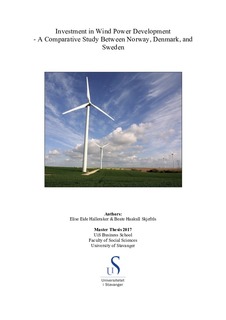| dc.description.abstract | This study analyses and compares the historical foundation of how governmental policies and policy instruments have shaped the development of onshore wind power in the three Nordic countries Norway, Denmark, and Sweden. In Denmark and Sweden, wind power has emerged as an important contributor to reduce pollution and global warming. In Norway, however, wind power has not developed to the same extent. This in spite of considerable potential and climate policies promoting use of electricity from renewable sources.
This analysis indicates that clear political ambition and generous financial support have been important factors in increasing the share of wind power in Denmark and Sweden. In comparison, the Norwegian policy has been vaguer, not stating specific goals in favour of wind power. The long lead time to get a licence from the authorities has also been an obstacle for the investors' willingness to invest in this market.
More specifically, institutional and policy-related differences across the countries are explored by assessing the profitability of a simulated project. This project is considered in Norway, Denmark, and Sweden to yield net present values (NPV) of -€26 245 604, -€13 500 032, and -€24 322 229, respectively. The analysis suggests the negative NPVs to result from the low electricity prices, in addition to low financial support and high investment costs. The countryspecific differences are mainly due to the size of the upfront investments needed. Denmark – flat, with little height variation, provides good geographical conditions for development of wind power; in addition, Denmark has an historical advantage, hence the lower investment cost.
The overall results show that a wind farm project will financially perform differently in the three represented countries. However, there is considerable uncertainty associated with these results. Sensitivity analyses show the electricity price to be the most critical variable affecting the NPV. Monte Carlo distributions paint a good picture of the uncertainty associated with these projects, thus, the uncertain variables must be closely monitored. | nb_NO |

